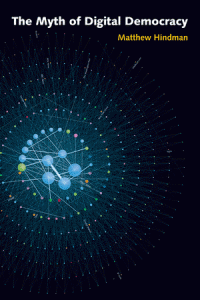
I recently read Matthew Hindman’s The Myth of Digital Democracy [1], in which he tears down the notion that the Internet has significantly democratised participation in the political sphere. I particularly enjoyed his data driven, economics approach to the issue, which reminded me of the methods used in Freakonomics [2] and my very favourite example of counter-intuitive cause and effect, in which postal voting actually decreased turnout at Swiss referendums [3].
Hindman’s core argument was that structure of the web itself prevents it from truly democratising participation—the way Google works, for example, bestows a rich-get-richer effect on content that is already widely linked. Interestingly, though, his work was based on a pre-social media Internet and he was largely talking about blogs as a mechanism for political discourse. I was left wondering what effect social media—which has undoubtedly changed some of the structure of the web—might have on his findings. Sharing and retweeting, for example, are recent structural elements that provide new opportunities for discovery (but certainly don’t even things out!)
With a focus on the impact of civic technology, and on web-based civic technologies in particular, it was natural that these issues would crop up at TICTeC. Shelley Boulianne’s opening keynote addressed it head-on with a meta-analysis [4] of research examining whether Internet use has a positive or negative effect on civic engagement. You don’t come across a lot of meta-analyses in design-led HCI research, so this was a nice change! Her analysis of 38 studies showed an overall positive effect. What’s interesting in this case is that it’s not the Internet acting as a tool for participation, but rather to better inform citizens and inspire them to participate through more traditional means.
Ethan Zuckerman’s closing keynote likewise did a great job of dismantling some assumptions around slacktivism—low-effort online activities like putting a Twibbon on your profile picture, which are widely regarded as being ineffectual. He argued that these simple but visible actions can actually go a long way towards challenging and ultimately changing social norms. For example, if a large number of your friends and family are visibly supporting gay marriage, this has a lot of normative influence. In this example, it is not just social media’s ability to get a large number of people involved that makes it effective, but also its ability to draw on influential social ties.
I think these examples go a long way to illustrating the wide variety of ways in which technology can have an impact, but also that sometimes need to go digging a little deeper to find them.
- Hindman, M. (2008). The Myth of Digital Democracy. Princeton University Press.
- Levitt, S.D. and Dubner, S.J. (2005). Freakonomics: A Rogue Economist Explores the Hidden Side of Everything. William Morrow.
- Funk, P. (2010). Social incentives and voter turnout: evidence form the Swiss mail ballot system. Journal of the European Economic Association 8(5), 1077–1103.
- Boulianne, S. (2009). Does Internet use affect engagement? A meta-analysis of research. Politcal Communication 26(2), 93–211.
Leave a Reply